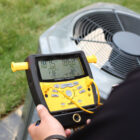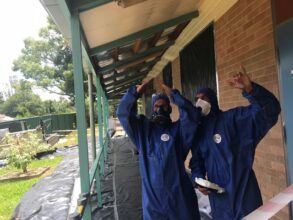Asbestos
HTS Group can help with sampling, removal and remediation of asbestos and lead from your home or renovation project.
When we’re finished your asbestos removal, you’re left with a safe blank canvas to enjoy the rest of your renovation without looming health risks threatening you and your family.
Asbestos was outlawed
in Australia in 2003
One in every three Australian homes is
expected to contain asbestos
Breathing in contaminated asbestos dust or asbestos fibres can lead to asbestosis, mesothelioma, or lung cancer
How do we tell if it’s asbestos?
First, we need to take a sample of the suspect product and send it to a NATA accredited lab.
We’ll always do this carefully; sometimes taking a small piece from behind a power point or switch can be a great non-invasive way of sampling. We’ll always seal up any exposed edges to ensure your safety.
If the lab results show asbestos, we can then remove it safely for you, dispose of it and remediate the area.
Find answers to some of the most common asbestos questions here, If you still have more questions, please get in touch.
Some of the precautions we take when removing asbestos:
Asbestos Removal Timeline

Signage and Access Control
When we’re ready to begin, the area will need to be cleared out and fenced for your safety.

Asbestos removal, Disposal, and Remediation
Anywhere from 1 day to a couple of weeks for stripping out a large multi storey commercial premises.

Clearance Inspection
Clearance certificate is provided by a third-party Asbestos Assessor
Asbestos FAQ
Is there a ‘safe level’ of asbestos exposure
No. Inhaling of any number of asbestos fibres can lead to asbestos related diseases such as asbestosis, mesothelioma, or lung cancer.
Is there a cure or treatment for Asbestos caused illnesses?
No, there are currently no known treatments or cures to asbestos related illnesses.
Can I remove asbestos myself?
There is legislation preventing, and heavy fines to deter, any PCBU (person conducting a business or undertaking) from removing asbestos from any non-residential property.
Can my builder remove asbestos legally?
Only if your builder is licensed for such works. There are heavy penalties for any trades who remove asbestos without appropriate licensing and training. Builders usually don’t have the required license for this type of work. Asbestos removal should be left to a licensed asbestos specialist.
Can I tell if a product is asbestos by the way it looks, feels or smells?
No, asbestos needs to be tested in a NATA lab. Asbestos was used in more than 3,000 ACM (asbestos containing materials) products in various quantities and mixes.
What is the difference between friable and non-friable asbestos?
Asbestos Containing Materials are either friable or non-friable.
Friable asbestos is high risk. Friable asbestos can be crumbled, pulverised, or reduced to a powder by hand pressure.
Non-friable asbestos is lower risk. It is mixed with cement or other hard bonding materials. Non-friable asbestos can become friable if damaged or old.
How does asbestos cause such a health risk?
When the tiny (usually microscopic) asbestos fibres are breathed in, they become lodged in the respiratory system, or sometimes even the lining of other organs. Over time, these microscopic fibres often create lesions which can turn cancerous.
What does PEMP stand for?
Project Environmental Management Plan (PEMP) used to identify, control, and manage environmental risks. These are used on larger projects where the asbestos removal may present an environmental risk and on large demolition and refurbishment jobs in NSW, SA, QLD and the ACT.
Where can HTS Group remove asbestos?
We remove asbestos from commercial properties right across NSW. We have a dedicated Northern Division, looking after Taree, Kempsey, Port Macquarie and surrounds.
Our Thornton office looks after asbestos removal in and around Newcastle, Lake Macquarie, Maitland, Singleton, Muswellbrook and the entire Hunter Valley.
Our Regional Projects Team offers asbestos removal to regional and remote locations across NSW, typically on larger projects like historic upgrades, and community and government refurbishments.
What type of Asbestos Removal License do you hold?
HTS Group holds a Class A Asbestos removal license, which is the highest asbestos removal license.
With a Class A friable asbestos license, you can remove any amount of friable asbestos, asbestos-containing material and asbestos-contaminated dust or debris. Read more about this license at Safe Work NSW
We have the experience, expertise, problem solving skills and the multi-skilled teams to deliver safe, professional, and timely projects around Newcastle, throughout regional NSW, and right across the country.






